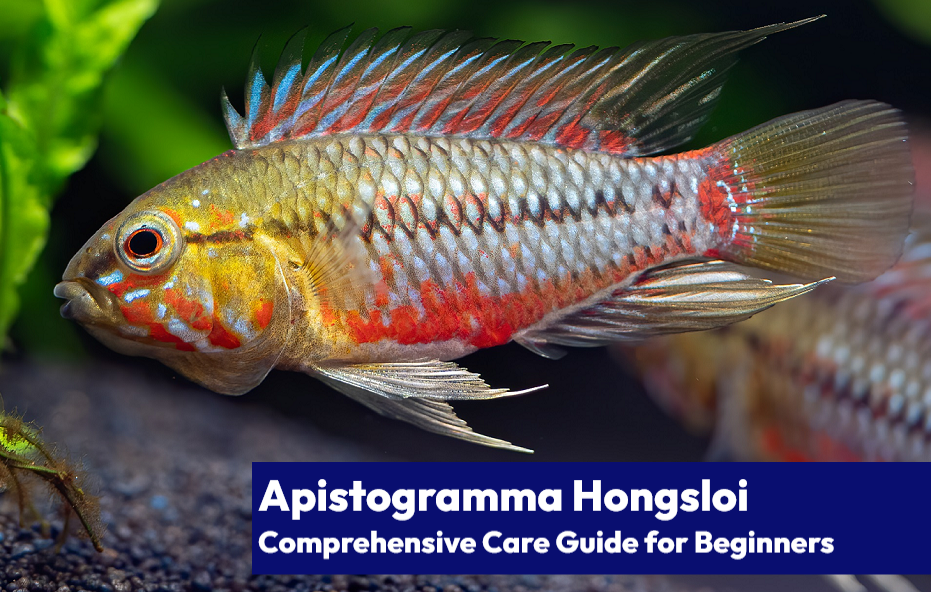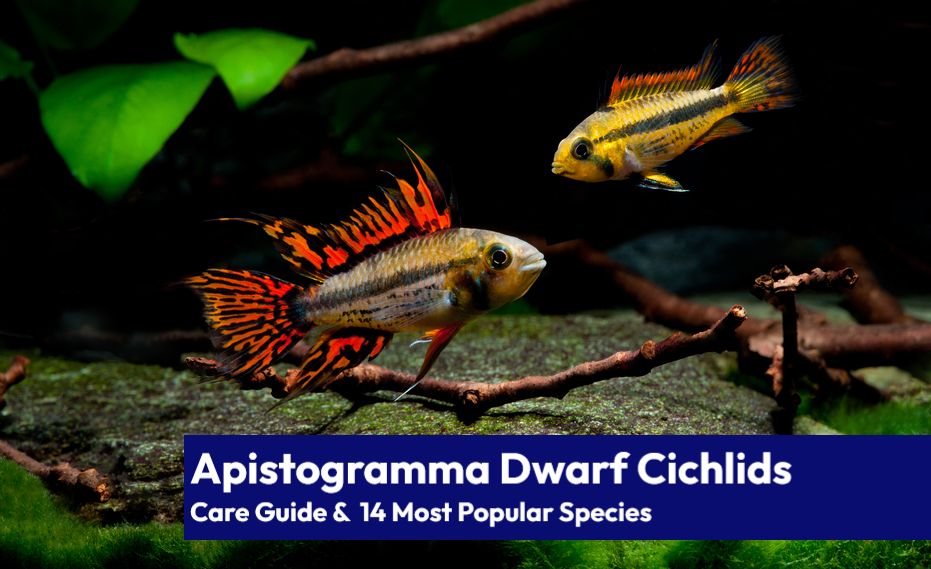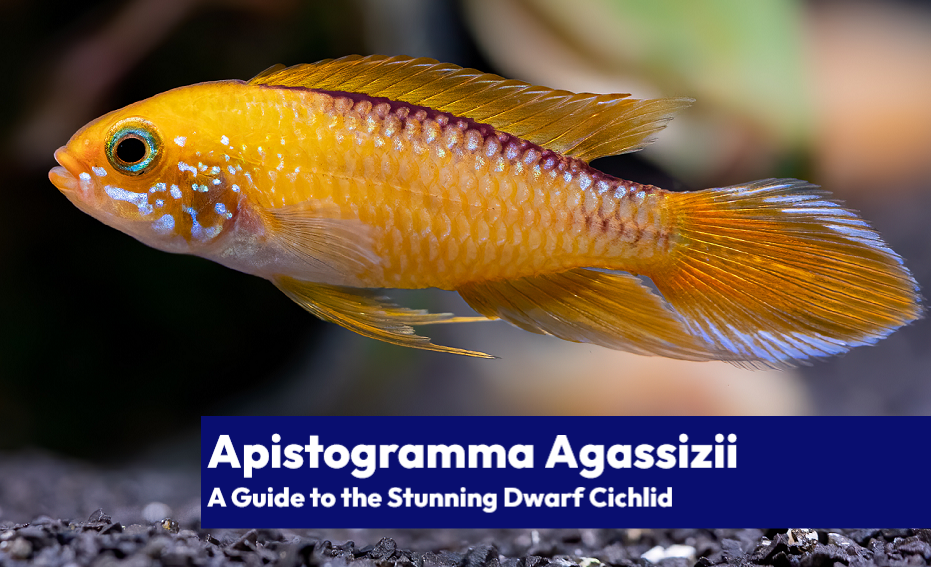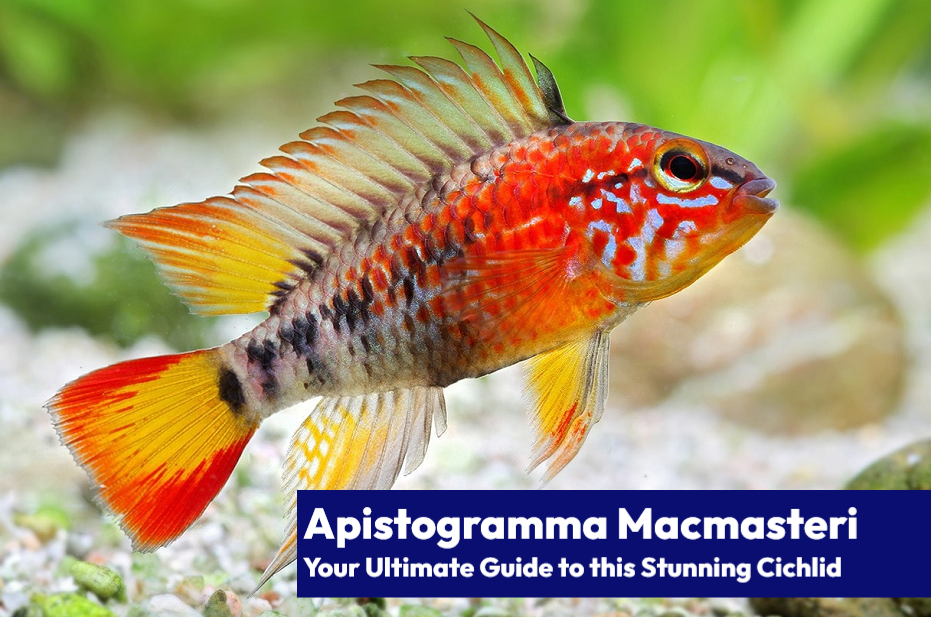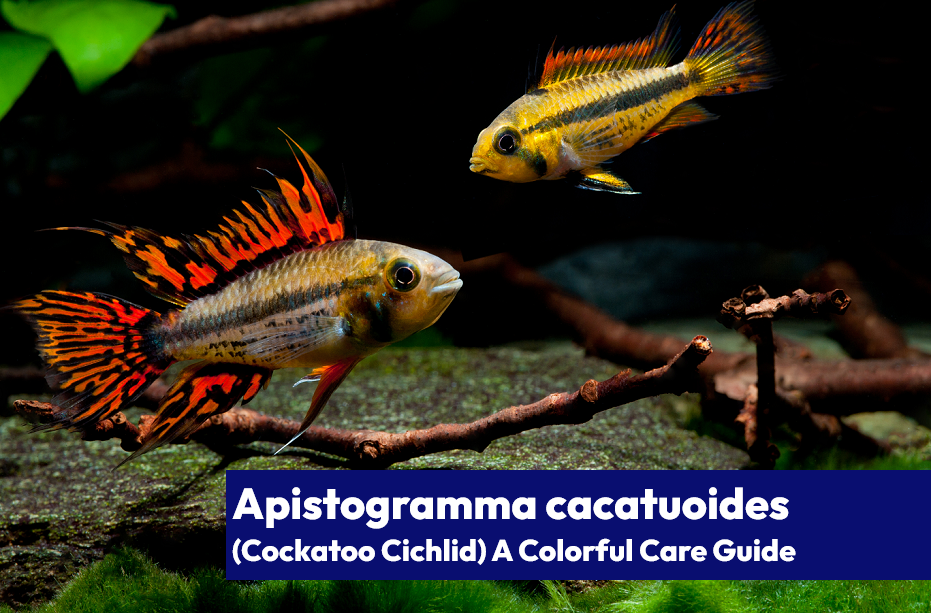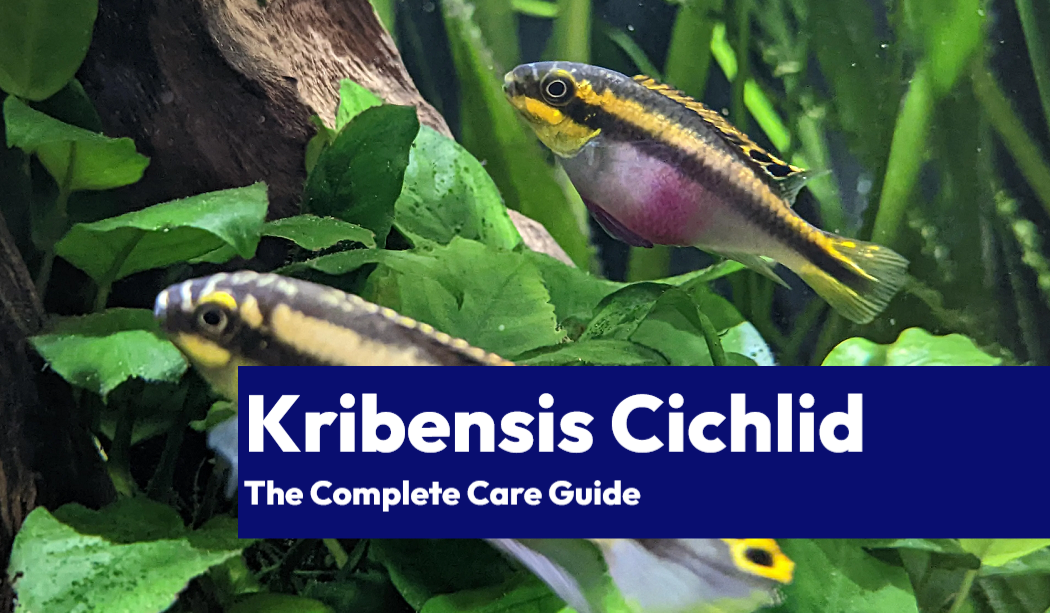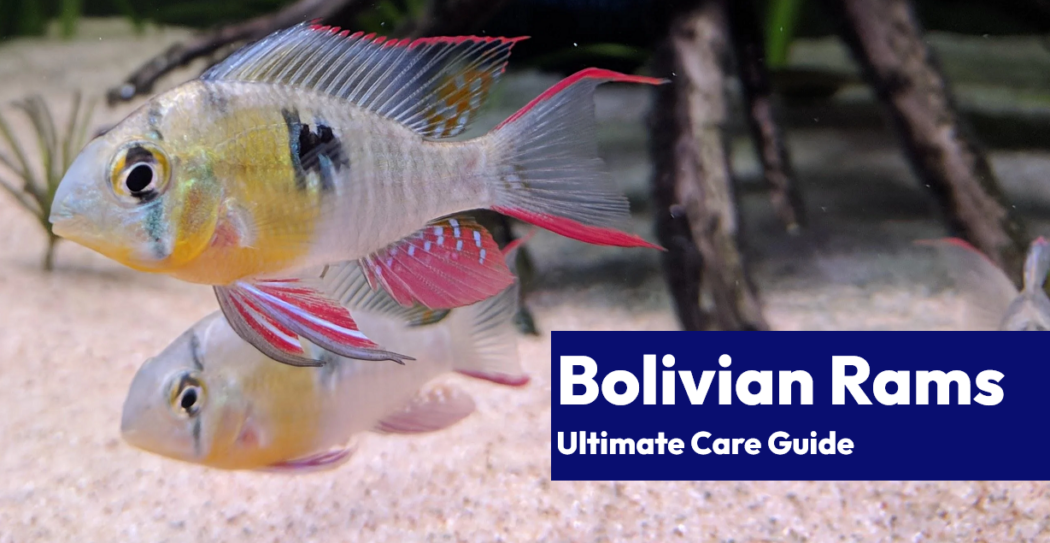Buckle up, fish fanatics! Today we’re diving into the enchanting world of Apistogramma hongsloi, a small, colorful dwarf cichlid that’s bound to steal your heart. 💖 So, strap on your scuba gear and let’s explore everything about these little aquatic wonders together!
The Hongsloi Lowdown: Not Your Average Dwarf Cichlid
Apistogramma hongsloi, also commonly known as Hongslo’s Red-Gold Dwarf Cichlid, is a captivating fish species with a big personality. These little guys may be small, but their unique appearance and behavior make them a popular choice for fish enthusiasts around the globe. And let me tell you, once you learn more about them, you’ll understand why they’re such a catch!
| Care Data | Apistogramma hongsloi (Hongsloi Dwarf Cichlid) |
|---|---|
| Scientific Name | Apistogramma hongsloi |
| Type | Freshwater |
| Adult Size | 2-3 inches (5-7.5 cm) |
| Tank Size | 20 gallons (75 liters) |
| Optimal Temperature | 74-82°F (23-28°C) |
| General Hardness dGH | 3-15° |
| Carbonate Hardness dKH | 1-6° |
| Optimal pH Range | 6.0-7.0 |
| Diet Type | Omnivore |
| Feeding Frequency | 2-3 times a day |
| Water Change Frequency | 30% weekly |
| Can Breed In Captivity? | Yes |
| Number of Fry (if applicable) | 20-50 |
| Spawning Type | Cave Spawner |
| Native Range | Colombia, Orinoco River Basin |
| Temperament | Peaceful |
| Schooling/Shoaling Fish | No |
| Known to Jump Out of Tank | No |
| Average Cost (USD) | $20-40 |
Colors and Patterns Galore: The Show-Stopping Looks of the Hongsloi Dwarf Cichlid

The Hongsloi Dwarf Cichlid is a true showstopper, with its vibrant colors and unique patterns that make it stand out among its peers. The males, in particular, are a sight to behold! Boasting a stunning mix of orange, red, and blue hues, they often have a bold, iridescent stripe running from their gills to the tip of their tail. Trust me, you can’t help but be mesmerized by these little guys!
But let’s not forget the lovely ladies of the Apistogramma hongsloi world! While they may not be as flamboyant as their male counterparts, female Hongsloi Dwarf Cichlids still rock some pretty impressive colors. They usually sport a more subdued palette of yellow and orange, with subtle black markings on their bodies. Plus, they’ve got this delightful “sheen” that gives them an extra touch of pizzazz.
Now, onto the ever-important topic of sexual dimorphism. Telling male and female Hongsloi Dwarf Cichlids apart is actually quite simple. As I mentioned earlier, males are more colorful and have a longer, more elaborate dorsal fin. Females, on the other hand, are smaller and have more rounded fins. So, with just a quick glance, you’ll be able to identify their gender with ease.
💡 Pro Tip: When selecting a pair for breeding, choose a male and female with the most vibrant colors and distinct markings. This will increase your chances of producing high-quality offspring!
Anatomy 101: A Closer Look at Apistogramma hongsloi
Hongsloi Dwarf Cichlids are small fish with big personalities, and their anatomy plays a significant role in their charm. They have a somewhat elongated body with a compressed, laterally flattened shape. This unique body form allows them to maneuver through tight spaces and hide in the nooks and crannies of their natural habitat.
The large, expressive eyes of the Hongsloi Dwarf Cichlid are another standout feature. These “windows to the soul” help them communicate with other fish and allow them to spot potential threats and prey with ease. Plus, who can resist the allure of those big, adorable eyes?
Finally, let’s talk fins. As I mentioned earlier, male Hongsloi Dwarf Cichlids have longer, more elaborate dorsal fins, while females have more rounded fins. These fins serve various purposes, including swimming, steering, and displaying dominance or readiness to mate. In a nutshell, the unique anatomy of these fish makes them incredibly adaptable and well-equipped for life in their native habitat.
How Big Do They Get? The Size and Growth Rate of Hongsloi Dwarf Cichlids
Adult Hongsloi Dwarf Cichlids typically reach a size of 2-3 inches (5-7.5 cm). Males are generally larger than females, but both genders remain relatively small compared to other cichlid species. The growth rate of Hongsloi Dwarf Cichlids is moderate, with juveniles reaching maturity at around 6-8 months of age.
Lifespan: How Long Do Hongsloi Dwarf Cichlids Live?
The average lifespan of a Hongsloi Dwarf Cichlid is 3-5 years. However, with proper care and optimal living conditions, these fish can live up to 7 years. Maintaining a stable environment with clean water, a balanced diet, and suitable tank mates can help ensure your Hongsloi Dwarf Cichlids live a long, healthy life.
Tank Size: Give Your Hongsloi Dwarf Cichlids the Space They Deserve
A minimum tank size of 20 gallons (75 liters) is recommended for keeping Hongsloi Dwarf Cichlids. This size provides ample swimming space and room for hiding spots, which are essential for these fish to thrive. For an optimal setup, consider a 29-gallon (110-liter) tank, which will comfortably house a pair or small group of Hongsloi Dwarf Cichlids along with compatible tank mates.

Water Parameters: Create the Perfect Environment
To keep your Hongsloi Dwarf Cichlids happy and healthy, maintain a water temperature between 74-82°F (23-28°C), a pH range of 6.0-7.0, and a general hardness (dGH) of 3-15°. These conditions closely mimic their natural habitat and will promote overall health and well-being.
Required Equipment: Setting Up Your Tank for Success
To create the ideal environment for your Hongsloi Dwarf Cichlids, you’ll need the right equipment. First, let’s talk filtration. I recommend using a sponge filter, as these filters are gentle and provide excellent biological filtration for small, delicate fish like the Hongsloi Dwarf Cichlid. Next up, lighting! An LED light with a timer will help simulate a natural day/night cycle and promote plant growth. Opt for a light that’s the appropriate length for your chosen tank size.
Now, let’s discuss heating. A 75-watt heater should be sufficient for a 20-29 gallon (75-110 liter) tank. This will ensure a stable temperature, which is vital for the health of your Hongsloi Dwarf Cichlids. And don’t forget about water conditioners and mineralizers! These products will help maintain optimal water parameters for your fish.
Lastly, consider adding some optional filter media, such as activated carbon or ceramic rings, to enhance water quality and clarity. These small touches can make a big difference in the overall health and happiness of your fish.
Habitat Requirements: Creating a Home Sweet Home
When setting up your tank, consider using a fine-grained, dark-colored substrate. Not only will this mimic their natural environment, but it will also enhance the vibrant colors of your Hongsloi Dwarf Cichlids. For functional decor and hardscape, include driftwood, rocks, and caves to provide hiding spots and mimic their native habitat.
💡 Pro Tip: Adding leaf litter and almond leaves can help create a more natural environment and provide additional hiding spots.
If you’re looking to add live plants to your tank, choose species that are compatible with Hongsloi Dwarf Cichlids. Some ideal options include Anubias, Java Fern, Cryptocoryne, Amazon Sword, and Dwarf Sagittaria. These plants not only provide shelter and hiding spots, but also contribute to water quality.

Feeding Time: What’s on the Menu for Hongsloi Dwarf Cichlids?
Hongsloi Dwarf Cichlids are omnivores with a preference for small, live or frozen foods. Offer a variety of food items to ensure a balanced diet:
- Brine shrimp
- Daphnia
- Bloodworms
- Tubifex worms
- High-quality flake food
- Pellets
- Crushed peas
- Chopped spinach
- Spirulina
- Mosquito larvae
Feeding frequency is essential for maintaining a healthy weight and promoting growth. Offer small, frequent meals, aiming to feed your Hongsloi Dwarf Cichlids 2-3 times per day.
Behavior and Temperament: What to Expect from Your Hongsloi Dwarf Cichlids
Hongsloi Dwarf Cichlids are peaceful, yet territorial fish. They are generally docile towards other species but can become aggressive towards their own kind, particularly during breeding. Males often establish small territories and defend them from rivals.
One unique behavior of Hongsloi Dwarf Cichlids is their ability to change color rapidly. This fascinating ability is used to communicate with other fish, display dominance, and even camouflage themselves from predators.
Tankmates: The Good, the Bad, and the Ugly
When selecting tankmates for your Hongsloi Dwarf Cichlids, choose peaceful, similarly sized species that won’t compete for territory. Ideal tankmates include:
- Cardinal Tetras
- Rummy-Nose Tetras
- Ember Tetras
- Corydoras Catfish
- Otocinclus Catfish
- Harlequin Rasboras
- Cherry Barbs
- Hatchetfish
- Kuhli Loaches
Avoid aggressive or large species, such as Oscars, Jack Dempseys, and large Plecos, as these fish can stress or even harm your Hongsloi Dwarf Cichlids.
Breeding: Let’s Make Some Baby Hongsloi Dwarf Cichlids
Breeding Hongsloi Dwarf Cichlids is relatively straightforward, but it requires a dedicated breeding tank with specific conditions. Maintain a water temperature of 79-82°F (26-28°C), a pH range of 6.0-6.5, and a dGH of 3-6°. Provide plenty of hiding spots, such as caves and dense plant coverage, to encourage spawning behavior.
Before breeding, condition the fish with live or frozen foods to stimulate the production of eggs and sperm. When the female is ready to spawn, her belly will become noticeably rounded. The male will then court the female, displaying his colors and performing a mating dance.
Once the female accepts the male’s advances, she will lay her eggs in a cave or on a flat surface. The male will then fertilize the eggs, and both parents will guard the nest. The eggs will hatch in about 3-4 days, and the fry will become free-swimming within a week.
It’s essential to provide the fry with proper nutrition to ensure healthy growth. Feed them newly hatched brine shrimp or microworms several times a day.
Diseases and Illnesses: Keep an Eye Out for These Common Issues
Hongsloi Dwarf Cichlids are generally hardy fish, but they can still be affected by common aquarium diseases. Keep an eye out for the following issues:
- Ich: Small white spots on the body and fins, indicating a parasitic infection.
- Fin rot: Fins become tattered, discolored, or begin to disintegrate.
- Dropsy: A bacterial infection causing the fish to swell due to fluid buildup.
- Swim bladder disorder: The fish has difficulty swimming or maintaining buoyancy.
- Fungal infections: White, cotton-like growths on the body or fins.
To prevent these issues, maintain proper water parameters, provide a balanced diet, and perform regular water changes.
Origin and Native Range: Where Do Hongsloi Dwarf Cichlids Come From?
Hongsloi Dwarf Cichlids (Apistogramma hongsloi) are native to the slow-moving rivers and tributaries of Colombia and Venezuela. They inhabit soft, acidic waters with plenty of submerged vegetation, leaf litter, and fallen branches.
Conservation Status: Doing Our Part for the Planet
Hongsloi Dwarf Cichlids are not currently listed as endangered or threatened. However, habitat destruction and water pollution in their native range pose potential threats to their survival. By providing a stable, suitable environment in your home aquarium, you can contribute to the conservation of this fascinating species.
Taxonomy: Who’s Related to Whom?
Hongsloi Dwarf Cichlids belong to the Cichlidae family and are part of the Apistogramma genus. Their closest relatives in the aquarium hobby include other Apistogramma species, such as Apistogramma cacatuoides, A. borellii, and A. agassizii.
| Kingdom | Animalia |
|---|---|
| Phylum | Chordata |
| Class | Actinopterygii |
| Order | Cichliformes |
| Family | Cichlidae |
| Genus | Apistogramma |
| Species | A. hongsloi |
Wrapping Up: All You Need to Know About Hongsloi Dwarf Cichlids
In conclusion, Hongsloi Dwarf Cichlids are an intriguing and colorful addition to any peaceful community tank. With proper care, a suitable environment, and compatible tankmates, these fish will reward you with their fascinating behavior and vibrant colors.
TL;DR:
- Hongsloi Dwarf Cichlids are peaceful, territorial fish with stunning colors.
- Ideal water parameters: pH 6.0-7.0, 75-79°F (24-26°C), and 3-10° dGH.
- Provide a variety of live, frozen, and dry foods for a balanced diet.
- Choose peaceful, similarly sized tankmates.
- Breeding is relatively straightforward with proper conditioning and a suitable environment.

Tim Priest, a renowned aquarium expert with over 15 years of experience in aquatic gardening and fish education, is dedicated to helping enthusiasts create stunning and thriving aquatic environments. As the founder of LearnTheAquarium.com, Tim shares his wealth of knowledge, passion, and expertise through engaging articles, educational resources, and personalized advice.
Discover the secrets to creating captivating underwater landscapes and maintaining healthy aquatic ecosystems. Join Tim on an exciting journey and let your aquarium adventure begin!
